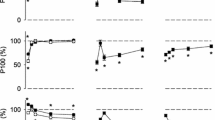Summary
The effects of 21 days voluntary leg (plaster) immobilization on the mechanical properties of the triceps surae have been studied in 11 young female subjects, mean age 19.4 years. The results show that during the period of immobilization the mean time to peak tension (TPT) and half relaxation time (1/2RT) and tension (Pt) of the maximal twitch increased significantly (p<0.001) but the effects were short lived. Maximal tension and contraction times of the twitch recovered within 2–14 days following the removal of the plaster cast. The electrically evoked tetanic tensions at 10 Hz and 20 Hz did not change significantly (p>0.1) during immobilization, but the 50 Hz tetanic tension (P°50) and maximal voluntary contraction (MVC) were reduced (p<0.05). The fall in P°50 and MVC was associated with 10% decrease in the estimated muscle (plus bone) cross-sectional area. The relative (%) change in P°50 and MVC following immobilization was related to the initial physiological status (as indicated by the response of the triceps surae to a standard fatigue test prior to immobilization) of the muscle. The rate of rise and recovery fall of the tetanus were slightly but significantly (p<0.01) reduced on day 7 of immobilization, but thereafter remained constant. The isokinetic properties of the triceps surae as reflected in the measured torque/velocity relation of the muscle in 4 subjects did not change significantly if account was taken of the slight degree of atrophy present following immobilization. It was concluded that short term voluntary leg immobilization produces atrophy and some loss of isometric twitch and tetanic function, but has little effect on the isokinetic properties of the triceps surae. The changes in the twitch characteristics during and immediately following immobilization may be indicative of a prolongation of the active state of the muscle.
Similar content being viewed by others
References
Barany M (1967) ATPase activity of myosin correlated with speed muscle shortening. J Gen Physiol [Suppl] 50:197–218
Booth FW, Kelso JR (1973) Effect of hindlimb immobilization on contractile and histochemical properties of skeletal muscle. Pflügers Arch 342:231–238
Briggs FN, Poland JL, Solaro RJ (1977) Relative capabilities of sarcoplasmic reticulum in fast and slow mammalian skeletal muscles. J Physiol 266:587–594
Burke RE, Levine DN, Tsairis P, Zajac FE (1973) Physiological types and histochemical profiles in motor units of the cat gastrocnemius. J Physiol 234:723–748
Close RI (1972) Dynamic properties of mammalian skeletal muscles. Physiol Rev 52:129–197
Davies CTM, Sargeant AJ (1975) Effects of training on the physiological responses to one- and two-leg work. J Appl Physiol 38:377–381
Davies CTM, White MJ (1982) Muscle weakness following dynamic excuse in humans. J Appl Physiol 53:236–241
Davies CTM, Mecrow IK, White MJ (1982) Contractile properties of the human triceps surae with some observations on the effects of temperature and exercise. Eur J Appl Physiol 49:255–269
Davies CTM, White MJ, Young K (1983) Muscle function in in children. Eur J Appl Physiol 52:111–114
Davies CTM, Thomas DO, White MJ (1985) Measurement of human muscle torque under isokinetic conditions using electrically evoked tetani. J Physiol 361:9P
Davies CTM, Thomas DO, White MJ (1987) Mechanical properties of young and elderly human muscle. Acta Med Scand (in press)
Ekblom B (1969) Effect of physical training on oxygen transport system in man. Acta Physiol Scand [Suppl] 328:1–45
Fischbach GD, Robbins N (1969) Changes in contractile in contractile properties of disused soleus muscles. J Physiol 201:305–320
Fitts RH, Courtright JB, Kim DH, Witzmann FA (1982) Muscle fatigue with prolonged exercise: contractile and biochemical alternations. Am J Physiol 242:C65–73
Kim DH, Witzmann FA, Fitts RH (1982) Effect of disuse on sarcoplasmic reticulum in fast and slow skeletal muscle. Am J Physiol 243:X156–160
Luff AR (1981) Dynamic properties of the inferior rectus, extensor digitorum longus, diaphragm and soleus muscles of the mouse. J Physiol 313:161–171
Ranatunga KW (1977) Influence of temperature on the characteristics of summation of isometric mechanical responses of mammalian skeletal muscle. Exp Neurol 54:513–532
Ranatunga KW (1982) Temperature-dependence of shortening velocity and rate of isometric tension development in rat skeletal muscle. J Physiol 329:465–483
Saltin B, Blomqvist G, Mitchell JH, Johnson RL, Wildenthal K, Chapman CB (1968) Response to exercise after bed rest and after training. Circulation [Suppl] 38 7:1–78
Simmons RM, Jewell BR (1974) Mechanics and models of muscular contraction. Rec Adv Physiol 9:87–147
Tabary JC, Tabary C, Tardieu C, Tardieu G, Goldspink G (1972) Physiological and structural changes in the cat's soleus muscle due to immobilization at different lengths by plaster casts. J Physiol 224:231–244
White MJ, Davies CTM, Brooksby P (1984) The effects of short-term voluntary immobilization on the contractile properties of the human triceps surae. J Exp Physiol 69:685–691
Witzmann FA, Kim DH, Fitts RH (1982) Recovery time course in contractile function of fast and slow skeletal muscle after hind limb immobilization. J Appl Physiol 52:677–682
Author information
Authors and Affiliations
Rights and permissions
About this article
Cite this article
Davies, C.T.M., Rutherford, I.C. & Thomas, D.O. Electrically evoked contractions of the triceps surae during and following 21 days of voluntary leg immobilization. Europ. J. Appl. Physiol. 56, 306–312 (1987). https://doi.org/10.1007/BF00690897
Accepted:
Issue Date:
DOI: https://doi.org/10.1007/BF00690897




